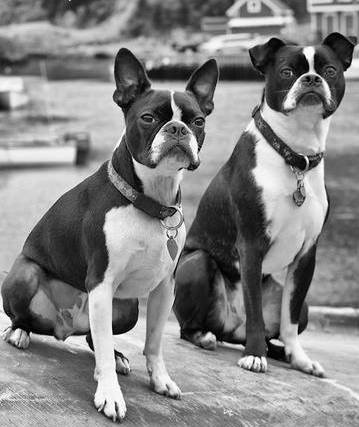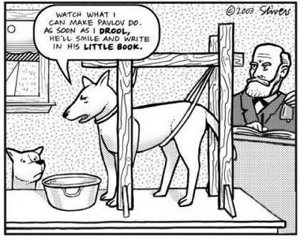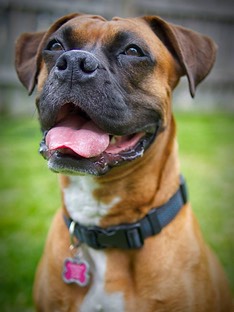Ken’s note: This one comes from Sarita Pellowe. I offered her a chance to do a guest blog and she jumped at it. It’s a good one so take note.

Cornerstones of Learning Theory:
Classical and operant conditioning have been the cornerstones of learning theory for the last century since B.F. Skinner expanded our knowledge of conditioning and introduced experimental analysis of behaviour (EAB) in the 1930s. There’s some big words and tricky concepts behind EAB, but they are concepts I think every dog owner should be aware of and able to apply to their day-to-day lives. Once these concepts become part of your daily routine, life with dogs gets a lot easier!
Let’s start with classical conditioning. Famously explored by Russian scientist Ivan Pavlov, classical conditioning is a learning process which pairs a positive stimulus (eg. Food, treat, play) with a neutral or negative stimulus (eg. New people, kids, vet visits, groomers, touch sensitivity). Classical conditioning is used to make our dogs form positive associations with well.. Pretty much anything! It is a fantastic tool to use in early socialization (for tips on the importance of early and proper socialisation, see Ken’s article for the Newfoundland Herald ) and when used effectively sets the groundwork for a well-adjusted, happy dog.
I’ll put it into context for you - say for example, you’re not fond of people who wear Blundstones (this is completely theoretical, they’re actually great shoes). If every time you saw someone wearing Blundstones, I gave you $5 – you’d start liking people wearing Blundstones, and I’d be broke. We can even increase the reward as you get more comfortable – what if every time someone wearing Blundstones approached you, or even came up and shook your hand – I gave you $20! You’re thinking “Wow! I love hipsters! I’m rich!”.
The same goes for our dogs. Your dog doesn’t like the neighbourhood cat, so every time the cat passes your window the dog gets kibble, scratch, good boy. Now you’re out for a walk and see the cat.. This time he gets a treat, scratch, good boy! The cat is walking towards him – oh my god, HOT DOGS?!?! Over time, the dog will learn that any time the cat is around (your neutral or negative stimulus) – good things happen!

Operants explained
Operant conditioning gets a little more complex, and is often misinterpreted by dog owners and trainers alike. Operant conditioning is the process of learning through consequences, by a behaviour being reinforced or punished. There are four consequences in operant conditioning, listed here from least to most aversive:
- positive reinforcement (yay!) – something is added to the situation to strengthen the behaviour and make it more likely to occur in the future eg. Getting a treat for sitting
- negative punishment – something is removed from the situation to discourage the behaviour and make it less likely to occur
- negative reinforcement – something is removed from the situation to strengthen the behaviour and make it more likely to occur in the future
- positive punishment (boo!) - something is added to the situation to discourage the behaviour and make it less likely to occur
Don’t get too caught up in the positive and negative – they aren’t describing emotionally positive or negative so the terms can be a little confusing – they simply mean something is being added to or taken away from the situation. In modern obedience training, negative reinforcement and positive punishment (the most aversive of techniques) are being used less over time because not only are they unpleasant for the dog, there are less aversive techniques available which actually work better (win win!). That’s not to say they haven’t been used in the past, and this is where I’ve seen many a trainer fall short for failing to get with the program. While the theories behind operant and classical conditioning have been around for over a century, it’s only been recently that dog training has moved towards relying on the more positive techniques. Unfortunately, some trainers are still stuck in the Dark Age. One of the clearest examples of negative reinforcement is the forced retrieve, which is taught by pinching a dog’s ears to cause pain and force the mouth open until the dog takes a dumbbell. The dog’s “reward” is the relief of not having his ears pinched anymore – ouch, right?
What if I told you there are trainers out there that still operate like this? Even bigger ouch.

What about punishments?
In terms of operant conditioning, a punishment is defined as “an action or stimulus that suppresses behaviour and makes it less likely to occur in the future”. This can include yelling, kicking, hitting, jerking the leash, squirting with a water bottle – but why would you want to? Personally, I don’t want a dog to fear me or feel uncomfortable around me. I want my dog, and any dog I work with, to see me as the source of all things good and fun. When your dog views you as a walking love and treat dispenser, beautiful things start to happen. They look to you for their social cues and perform desired behaviours to increase their chances of you dishing out something good. Not only that, if your dog is having fun it likely means you are too, which can only mean good things for you and your pup!
Dogs are simple beings (god love ‘em) – they commit an action in order to gain a desired reaction. A dog jumps up because (aside from the fact he hasn’t been taught how to properly greet people) he is looking for your attention, and has likely received it in the past from being greeted by one of two camps – the first is someone like myself who relishes the attention of new dogs (“OOOOOOOOOOOOOH LOOK AT THE PUPPY OH DO YOU WANT SCRATCHES HERE’S A TREAT YES PUT YOUR PAWS ON MY SHOULDERS LET’S HAVE A CUDDLE OH MY YOU’RE ACTUALLY TALLER THAN ME LOOK AT THAT!”)
I’m working on being less of a bad influence in this department!.
The second camp of people are those who don’t want to be jumped on (dog gets yelled at, pushed off etc).
In both cases, the dog is getting his desired reaction (attention), and he hasn’t learned what is or isn’t appropriate when greeting a human. The biggest problem of running into someone like me is, if it’s a semi-regular occurrence, the dog isn’t going to be able to distinguish dog lover from dog hater, or young and supple (I’m not that old yet) from old and frail. If a dog knocks me on my ass, I can brush myself off and remind myself not to be a menace. If he does it to an elderly person, or a small child, or someone with a physical disability, it’s not going to end nicely for any of us.
Take this sequence of events for a dog jumping up:
- Dog jumps up on human
- Human turns around or backs away
- Dog sits on floor
- Human rewards dog
Punishment does not have to be cruel
In this instance, the turning around/backing away (ie. withholding attention in response to an undesirable behaviour) is a punishment! “My goodness, how cruel!” – I can hear the clicker trainers sharpening their pitchforks already. The truth is, withholding attention is a means of suppressing a behaviour and making it less likely to occur in the future - just because something acts as a punishment, it doesn’t mean it has to be cruel. The simplest of things we do with our dogs on a daily basis can be classified as a punishment – which makes it pretty difficult to claim that you are 100% positive reinforcement.

Take another example – a dog pulling on a leash when out for their daily walk:
- Dog pulls
- Human stops walking forwards (or even moves backwards)
- Dog achieves loose leash
- Dog and human move forward, dog rewarded
Again here, the simple act of stopping walking acts as a punishment. Dog wants to move forward, dog pulls, human stops, dog stops moving forward. Where attention was the reward in the first example, here the reward is resuming the walk. For anyone who has done class with us, this example forms the basis for the “Too Bad So Sad” exercise.
For the eagle-eyed reader, you will notice that in both of these examples the sequence of events doesn’t stop at the punishment. Why?
Because cruelty-free punishment on its own does not work.
I say “cruelty-free” because I do not ever, no matter what the circumstance, agree with positive punishment (ie. causing any level of harm or discomfort to your dog). Cruelty-free punishment as I describe in the above examples is just one small part of teaching your dog. It has to be followed up with a well-timed reward for a desired behaviour. In each example we follow up the ‘punishment’ by encouraging a good behaviour (sitting to be greeted, or achieving loose leash) and most importantly rewarding it! This is absolutely 100% crucial and I cannot stress it enough – your dog at some point is going to do something wrong. That’s when we have to step in, step up, and teach them. Think about the best teacher you had at school, or the best boss you had at work – I can guarantee they told you when you were wrong, but followed up with encouragement and guidance in order for you to learn and grow. The alternative is a bad leader who constantly tells you “No!”, who puts you down and belittles you when you’re wrong, and offers no guidance. That’s not what we want for us or our dogs, but we as humans are pretty bad for inventing rules and boundaries for our dogs without actually letting them know what they are - until it’s too late.
What’s the solution?
For me, it’s encouraging fear-free, reward-based learning. That means not only rewarding good behaviours in your dog, but communicating to your dog exactly what it is you expect from them, and rewarding that too. If your dog does something wrong – re-educate him! Take some time to make sure you as an owner are doing your part. There’s no need to yell/kick/jerk your dog – it’s unpleasant to say the least and has a huge chance of backfiring, which can only end badly (see Ken’s blog post about Why Punishment Does Not Work)
Extra Reading
For a closer look at classical and operant conditioning in dogs, and the training philosophies of some of the best in the business – check out the following links.
How To Apply Classical Conditioning to Your Dog (Dr Ian Dunbar):